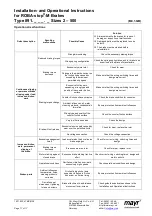
Installation- and Operational Instructions
for ROBA-stop
®
-M Brakes
Type 891. _ _ _ . _ Sizes 2 – 500
(B.8.1.GB)
16/11/2005 TK/KE/RJ
Chr. Mayr GmbH + Co. KG
Tel.: 08341 / 804-0
Eichenstraße 1
Fax: 08341 / 804-421
D-87665 Mauerstetten
http://www.mayr.de
Page 2 of 17
Germany
eMail:
info@mayr.de
Safety Guidelines
These safety guidelines are user hints only, and may not be complete!
Danger!
Lethal danger! Do not touch voltage-carrying cables
and components.
To prevent injury or damage, only professionals and
suitably qualified personnel should work on the devices.
Danger!
This caution applies when:
the electromagnetic brake is used incorrectly.
the electromagnetic brake is manipulated or converted.
the relevant safety standards for safety and/or installation
conditions are ignored.
Warning!
Before machine installation and operation, please
read the installation and operational instructions
carefully. Please follow the safety guidelines to avoid
injury or damage.
The electromagnetic brakes have been developed in
accordance with the latest technology regulations for
the time and are, at the point of delivery,
operationally safe.
Information:
Without measuring its conformity, this product is NOT suitable
for use in areas where there is a high danger of explosion. This
statement is based on the regulation 94/9 /EC (ATEX regulation)
Caution!
Only professional, qualified personnel, trained in the
transport, installation, starting operations, maintenance and
general operation of these devices as well as the relevant
norms, should be allowed to carry out this work.
Technical data and specifications (type tags and
documentation) must be followed.
The correct connection voltage must be connected
according to the information on the type tag.
Never loosen electrical connections or carry out
installations, maintenance or repairs while the connecting
voltage is switched on.
Cable connections must not be pulled taut.
Check electrical components for signs of damage before
putting them into operation. Never bring them into contact
with water or other fluids.
The braking torque can be lost, when the friction lining
and/or the friction surface come into contact with oil or
grease.
Appointed use
mayr
®
brakes are for use in machines and systems and may
only be used in the situations for which they are ordered and
confirmed.
Using them for any other purpose is not allowed.
Guidelines for Electromagnetic Compatibility
(EMC)
In accordance with the EMC Regulations
89/336/EEC, the single components produce no
emissions. However, functional components such as
the line-side energising rectifier for the brakes along
with the phase demodulator, the ROBA
®
-switch or
similar controls can produce disturbance which lies
above the allowed measurements.
For this reason it is important to read the installation
and operational instructions very carefully and to
keep to the EMC guidelines.
Device Conditions
The catalogue values are guideline values which
can, in certain cases, vary. When designing the
brakes, please allow for varying installation
situations, brake torque fluctuations, permitted
friction work, run-in behaviour and wear as well as
for general ambient conditions, all of which should
be carefully assessed and adjustments made
accordingly.
Caution!
Connection and extension dimensions must be adjusted
according to the size of the brake at the place of work.
The brakes are designed for a relative duty cycle of 100 %.
The brakes are only designed for dry running. The torque
can be lost, if the friction lining comes into contact with oil,
grease or water.
The braking torque is dependent on the present run-in
condition of the brake.
Please check the manufacturer-side corrosion protection for
the metallic surface.
Protection Class I
This protection can only be guaranteed if the basic insulation is
intact and if all conductive parts are connected to the Protective
Earth conductor. Should the basic insulation fail, the contact
voltage cannot function (VDE 0580).
Protection Type (mechanical) IP 54:
When installed, components should be protected against dust,
contact and splashing water from all directions (dependent on
customer-side friction flange).
Protection Type (electrical) IP 54:
Please protect device from dust and contact as well as from
splashing water from all directions.
Ambient Temperature from –20 °C up to +40 °C
Danger!
The torque can be strongly affected by condensation at
temperatures around or under freezing point, or the rotors can
freeze up. The user is responsible for suitable protective
measures against these problems.
Thermic Class F (+155 °C)
The magnetic coil and the casting compound are suitable for use
up to operational temperatures of +155 °C.



































